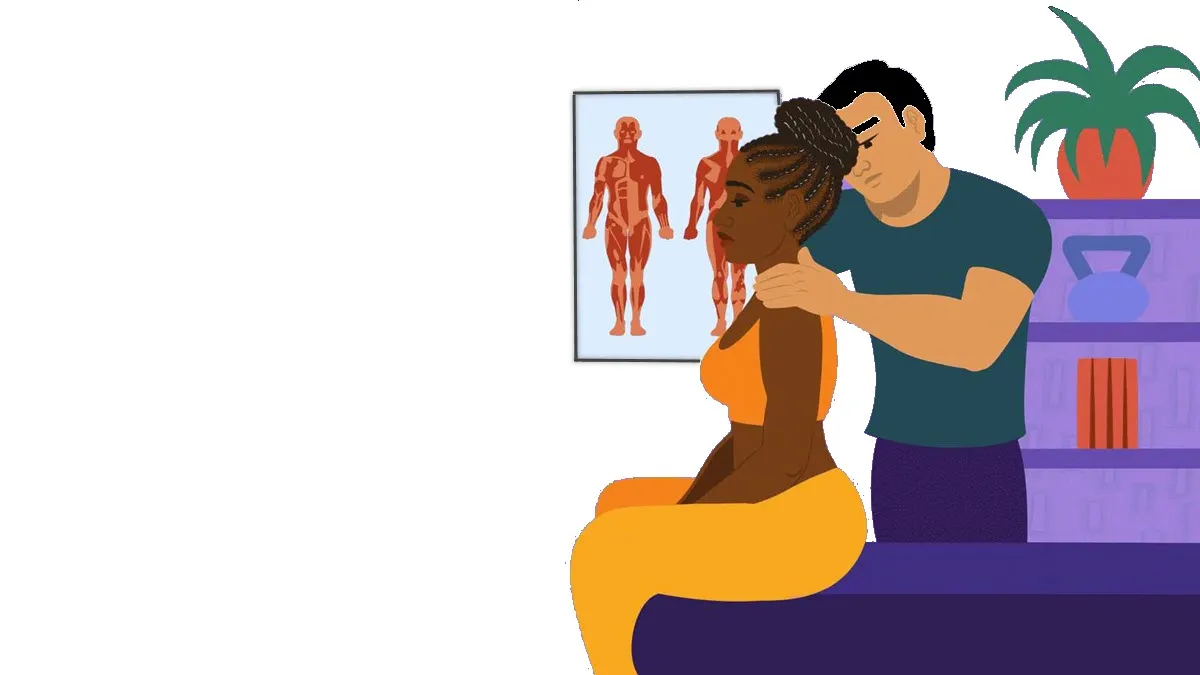Introduction
The psoas muscle, often overlooked in the context of pregnancy and childbirth, is emerging as a valuable well-being guide offered by osteopathy. Located deep in the abdominal cavity, the psoas is intimately linked to the pelvis, spine and overall body posture. Exploring its role during pregnancy and childbirth offers a fascinating perspective on its influence as a facilitator of the physical and emotional well-being of expectant mothers.
During pregnancy, the psoas may undergo significant changes due to postural adjustments related to fetal growth. Osteopaths specializing in the care of pregnant women recognize the importance of maintaining muscular balance around the psoas to promote optimal posture. By working on the flexibility and mobility of the psoas, osteopaths can help relieve tension related to pregnancy, improve posture and prepare the body for childbirth.
During labor and delivery, the psoas plays a crucial role as a stabilizer of the pelvis and facilitator of the baby’s movements through the birth canal. Osteopaths use specific techniques to help release tension in the psoas, allowing for more efficient labor and reduced physical stress for the mother.
An osteopathic perspective on the psoas during childbirth also encompasses the emotional dimension. The psoas is often associated with the body’s fight or flight response, and releasing tension in this area can contribute to a smoother, less emotionally stressful birth. Pregnant women thus benefit from a holistic approach that takes into account both the physical and emotional aspects of this transformative period.
Taking the psoas into account as a guide to well-being during childbirth is part of the broader framework of the holistic approach to osteopathy. By emphasizing muscular balance, mobility and stress management, osteopaths help create a supportive environment for a positive birth and optimal postpartum recovery.
In conclusion, the osteopathic perspective on the psoas during pregnancy and childbirth offers an integrated view of maternal well-being. By working in collaboration with other health professionals, osteopaths play an essential role in supporting future mothers towards a balanced and positive birth experience.
Renzo Molinari, an obstetric osteopath working in several specialist clinics in London, including the Birth Company, presented a captivating discussion focusing on fetal position to optimize an easy birth. It highlights the importance of understanding where and in what position the baby is to influence and best prepare the mother for a comfortable and rapid delivery.
Molinari claims that osteopathy can improve childbirth by treating the mother and thus influencing the fetal position. According to him, the easiest delivery occurs when the baby is optimally positioned, with the head in contact with the pubis and the occiput on the left. This optimal position is the result of babies rotating clockwise due to the shape of the pelvis during birth. Thus, if the baby’s head is already on the left side, the distance to travel before exiting the mother’s pelvis is reduced.
Molinari explains that if the baby’s right occiput is in the posterior position, the delivery will be longer because the baby will have to travel a greater distance. If the baby’s left occiput is posterior, it will take even longer, as the baby will have to go all the way around the pelvis to come out. This type of childbirth is very long, painful and carries neurological risks for the baby due to the numerous rotations and movements during childbirth.
He shared an interesting experience involving a family with an infant who wouldn’t stop crying. When he held the baby, the baby wanted to stretch his body. Instead of stopping her, he allowed her to lie down, and her head touched his sacrum. In this position, she immediately stopped crying and fell asleep for a few minutes. After that, she woke up, returned to a normal position and no longer cried. Molinari explained that the extended position was probably that of the baby in the womb, and it was his comfortable and pleasant place. After allowing this position, the baby was able to become more comfortable, and parents reported a complete cessation of continuous crying.
Molinari pointed out that the most intense pain women initially feel during labor is the spasmodic contraction of the psoas muscle. According to him, working on the psoas before childbirth is very effective in preventing this. By working on relaxing the psoas muscle and diaphragm, it creates more space for the uterus throughout pregnancy, making it easier for women to lie on their back. This also prevents compression of the inferior vena cava and thus reduces dizziness and vomiting.
This presentation was extremely interesting and eye-opening to the amount of change an osteopath can make during pregnancy and childbirth [Reference_Molinari].
Psoas Changes During Pregnancy
During pregnancy, several physiological and anatomical changes affect the woman’s body, including postural adjustments related to the growth of the fetus. The psoas muscle, which is a deep muscle located in the lumbar region of the spine, plays a vital role in these adaptations.
- Postural adjustments linked to fetal growth:
- Increased lumbar lordosis: As the fetus develops, the pregnant woman’s center of gravity shifts forward. This can lead to an increase in the natural curvature of the lumbar spine, called lumbar lordosis. The psoas is involved in maintaining this curvature and can undergo changes to adapt to this new position.
- Elongation of the psoas: The growth of the uterus can put pressure on the psoas, causing it to stretch. This can influence the function of the muscle and potentially lead to muscle imbalances.
- Maintaining muscular balance around the psoas during pregnancy:
- Pelvic Stability: The psoas is connected to the spine and inserts onto the femur. It plays an important role in maintaining pelvic stability. Muscle imbalances around the psoas can contribute to problems such as lower back pain, postural disorders and discomfort during pregnancy.
- Pelvic Floor Engagement: The psoas is also linked to the pelvic floor, and its proper functioning is essential for the health and support of this region. Exercises to strengthen the pelvic floor can help maintain muscular balance in the psoas region.
- Specific exercises: Exercises focused on strengthening the core muscles, including the psoas, can help minimize muscle imbalances and prevent back pain during pregnancy. However, it is crucial to consult a healthcare professional before undertaking any exercise program during pregnancy to ensure safety and effectiveness.
Osteopathy and Maternal Well-Being
Osteopathy specializing in maternal wellbeing can play an important role in relieving pregnancy-related tension and improving posture, often focusing on key areas such as the psoas. Here is how specialist osteopaths can contribute to these aspects:
- Relief from pregnancy-related tensions:
- Overall body assessment: Specialist osteopaths carry out a complete assessment of the pregnant woman’s body to identify areas of tension, movement restriction and discomfort. This may include evaluating the pelvis, spine, pelvic muscles, diaphragm, and of course, the psoas.
- Restoring balance: Using gentle manual techniques, osteopaths work to restore the body’s structural balance. They can release tension in joints, muscles and connective tissues to relieve discomfort associated with pregnancy.
- Improved circulation: Osteopathic manipulations can promote blood and lymphatic circulation, which can be beneficial in reducing swelling and improving tissue nutrition.
- Improvement of posture and preparation for childbirth through manipulation of the psoas:
- Work on the psoas: Osteopaths can use specific techniques to assess and manipulate the psoas. This may include stretching, myofascial releases, and muscle balancing techniques to help release built-up tension in that muscle.
- Postural corrections: Osteopathic adjustments often aim to improve the overall posture of the pregnant woman. This can help relieve back and pelvic pain while preparing the body for birth by promoting optimal baby position.
- Emotional support: In addition to the physical benefits, osteopathy sessions can provide important emotional support. Specialist osteopaths take into account the holistic aspect of pregnancy, helping women to feel more comfortable and in tune with their body during this period.
The Psoas during Labor and Childbirth
The psoas, a deep muscle located in the lumbar region of the spine, plays a crucial role during labor and delivery as a stabilizer of the pelvis. Its function is complex and goes beyond simple stabilization, as it is also involved in hip flexion movements. Here’s how the psoas is important during labor and delivery, as well as specific techniques used by osteopaths to release associated tension:
- Crucial role of the psoas as a stabilizer of the pelvis:
- Pelvic stabilization: During labor, the psoas helps maintain the stability of the pelvis, which is crucial for a successful delivery. A properly functioning psoas promotes optimal pelvic position for the baby’s passage through the birth canal.
- Participation in hip flexion movements: During the expulsion phase, the psoas can be used to facilitate the mother’s hip flexion movements. This activation of the psoas can help create adequate space for the baby to pass through.
- Muscle coordination: The psoas works in collaboration with other muscles in the trunk, pelvis and lower extremities to ensure optimal muscular coordination during labor, promoting a smoother birthing process.
- Specific techniques used by osteopaths to release tension during labor:
- Gentle stretching: Osteopaths may use gentle stretching techniques to release tension in the psoas. These stretches aim to improve the flexibility of the muscle, thus promoting better mobility during work.
- Myofascial release: Osteopaths may use myofascial release techniques to target areas of tension in the psoas and surrounding tissues. This can promote muscle relaxation and improve flexibility needed during the birthing process.
- Gentle manipulations: Gentle osteopathic manipulations can be applied to restore overall muscular balance, thereby promoting optimal psoas function during labor.
- Postural advice: Osteopaths can also provide postural advice to help women in labor adopt positions that minimize strain on the psoas and facilitate the birthing process.
It is important to note that any intervention during labor should be carried out in collaboration with the medical team responsible for the pregnancy. Osteopaths specializing in maternity can play a complementary role, working closely with healthcare professionals to support women’s physical and emotional wellbeing during labor and birth.
The emotional dimension of the psoas is an important component, as this muscle is often associated with the fight or flight response, also known as the “stress response.” The psoas, as a deep muscle located in the lumbar region of the spine, responds to emotional and psychological stimuli, in addition to its physiological functions. Here’s how the psoas is linked to the fight or flight response and how releasing tension in this area can contribute to a less emotionally stressful birth:
Emotional Dimension of the Psoas
- Association of the psoas with the fight or flight response:
- Stress Response: The psoas is often called the “fight or flight muscle” because it is activated in response to stress. When we face stressful situations, the psoas can contract, preparing the body to respond quickly by preparing for fight or flight.
- Built-up tension: Emotional tension, chronic stress, or traumatic experiences can manifest physically in the psoas, leading to prolonged contraction of the muscle. This tension can influence posture, movement and overall emotional well-being.
- Release of tensions in this area for a less emotionally stressful childbirth:
- Holistic approach: Osteopaths specializing in maternity can adopt a holistic approach by considering the emotional dimension of the psoas. They can use specific techniques to release accumulated tension in the psoas, thus promoting emotional relaxation.
- Stress reduction: By releasing tension in the psoas, osteopaths can help reduce stress and anxiety levels in pregnant women. A more relaxed psoas can promote a calmer and more balanced emotional state.
- Emotional preparation for childbirth: Releasing tension in the psoas can also help the mother-to-be prepare emotionally for childbirth. A flexible, relaxed psoas can make it easier to adapt to the physical and emotional changes associated with pregnancy and childbirth.
- Improved mind-body connection: Techniques to release the psoas can help improve the mind-body connection. This can be beneficial in creating a more positive emotional environment during childbirth.
Creating Space for the Uterus
- Psoas and pelvis mobility:
- Influence on the position of the pelvis: The psoas is attached to the lumbar vertebrae and crosses the pelvis to attach to the femur. When the psoas is tense or contracted, it can influence the position of the pelvis. A relaxed psoas promotes better pelvic mobility, which can create a more optimal space for the uterus.
- Prevention of pelvic compression: A tight psoas can contribute to a less favorable pelvic position, which can potentially lead to pelvic compression and limit the space available for the uterus. Relaxing the psoas can help prevent these compressions and promote better blood and lymphatic circulation in the pelvic area.
- Diaphragm and breathing:
- Connection between diaphragm and psoas: The diaphragm, as the main respiratory muscle, is also connected to the psoas. When the diaphragm contracts during inspiration, it can influence tension in the psoas and vice versa. A relaxed diaphragm contributes to deeper breathing and better relaxation of the psoas.
- Effect on abdominal space: The diaphragm separates the thoracic cavity from the abdominal cavity. When it contracts, it can put pressure on the abdomen. A relaxed diaphragm allows freer movement and expansion of the abdominal cavity, creating more space for the expanding uterus during pregnancy.
- Techniques for relaxing the psoas and diaphragm:
- Specific stretches: Targeted stretches can be used to release the psoas. These stretches aim to lengthen the muscle and release accumulated tension.
- Deep breathing exercises: Deep breathing exercises can help relax the diaphragm. Deep breathing fully engages the diaphragm, thus promoting its relaxation and contributing to better mobility of the psoas.

















